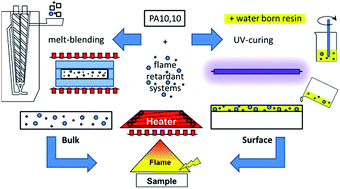Bulk vs. surface flame retardancy of fully bio-based polyamide 10,10†
Abstract
First, polyamide (PA) 10,10-based compounds with enhanced flame retardant properties have been prepared by melt-blending. To this aim, a traditional intumescent formulation consisting of ammonium polyphosphate (APP) and pentaerythritol (PER) derived from oil chemistry has been added to PA 10,10 (30 wt% loading) and the resulting morphological, mechanical and flame retardant properties have been investigated. In order to achieve the highest carbon content from bio-source, PER has been replaced by corn starch: thus, it was possible to compare the thermal, mechanical and combustion properties of the compounds containing non-bio additives (APP and PER) with those of the starch-containing counterparts. Furthermore, the same intumescent ingredients adopted in bulk have been further used for coating PA 10,10 surface, exploiting a UV-curing process. From an overall point of view, cone calorimetry tests have shown that these bulk formulations are able to reduce total heat release and peak of heat release rate – pkHRR – (about 30%), but, contrariwise, they lower time to ignition and increase the smoke production, as well. A similar trend has been found when the flame retardants were added to a UV-curable system coated on PA 10,10 samples, without taking into consideration the effect of specimen mass. Conversely, when the combustion parameters were normalized to the specimen mass, the reduction of pkHRR was significantly higher than that found with the same FR content in bulk (about −65 vs. −35%, respectively). As a consequence, the flame retardant results achieved by the surface approach seem to be more promising than those from melt-blending.


 Please wait while we load your content...
Please wait while we load your content...